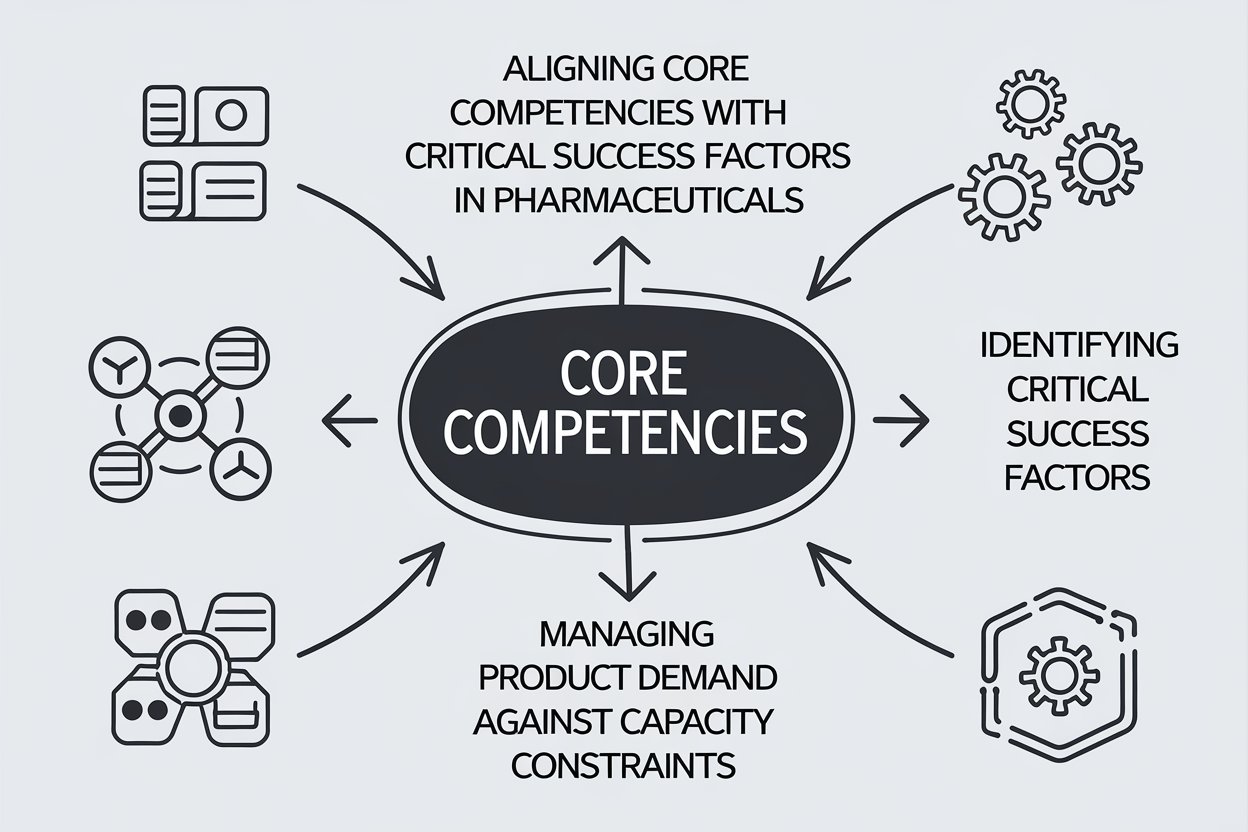Q.NO.6 “Aligning Core Competencies with Critical Success Factors in Pharmaceuticals and Managing Product Demand Against Capacity Constraints”.

(a) Aligning Core Competencies with Critical Success Factors (CSF) in a Pharmaceutical Firm
A Critical Success Factor (CSF) is an essential element or activity that a company must do well to achieve its goals, while core competencies are the unique strengths or capabilities a firm possesses that give it a competitive advantage. For a pharmaceutical firm, aligning core competencies with CSFs is crucial for sustained success. Here’s how a manager can approach this:
1. Identify the Critical Success Factors (CSFs) in the Pharmaceutical Industry
- Regulatory Compliance: Strict adherence to government and international regulations (FDA, EMA) for drug approval and safety.
- Innovation in R&D: Developing new and effective medications requires continuous research and innovation.
- Quality Control: High-quality standards in manufacturing processes to ensure safe and effective products.
- Speed to Market: Minimizing the time between drug discovery and market introduction.
- Cost Efficiency: Managing costs effectively while ensuring high-quality production and distribution.
2. Align Core Competencies with CSFs
A pharmaceutical firm’s core competencies can include specialized R&D capabilities, advanced manufacturing processes, skilled workforce, and strong relationships with regulators. Aligning these with CSFs can be achieved through:
- Leveraging R&D Excellence: A strong R&D department ensures the firm stays at the forefront of drug development and innovation, directly contributing to the CSF of innovation in R&D. By investing in advanced technology and talent, the firm can enhance its ability to develop breakthrough drugs faster.
- Ensuring Regulatory Expertise: Developing deep knowledge of regulatory requirements can be a core competency. By aligning this with the CSF of regulatory compliance, the firm can reduce approval delays and improve product safety protocols, minimizing the risk of regulatory issues.
- Optimizing Manufacturing Processes: By honing efficient and quality-driven manufacturing as a core competency, the firm can align this with the CSF of quality control and cost efficiency. Implementing automated systems and best practices can ensure both consistent quality and cost savings.
- Collaborating with Key Partners: A core competency in forming strategic partnerships with suppliers, healthcare providers, and research institutions can help the firm address the CSF of speed to market. These collaborations can reduce delays in development and distribution.
(b) Managing Product Demand in Light of Available Capacity
An operations manager must effectively manage the demand for a product while considering the firm’s capacity constraints. Capacity refers to the maximum output a company can produce, and managing demand within these limits is crucial for maintaining efficiency and customer satisfaction. Here’s how this can be achieved:
1. Demand Forecasting
- Overview: Accurate forecasting helps predict future demand based on historical sales data, market trends, and customer behavior. It allows the manager to plan for production needs in advance.
- Example: A pharmaceutical firm launching a seasonal flu vaccine can use demand forecasting to anticipate how many doses will be needed based on past flu seasons, current health trends, and government advisories.
2. Capacity Planning
- Overview: Ensure the firm’s available production capacity is aligned with forecasted demand. This involves determining whether the current facilities, workforce, and resources can meet the expected demand or if adjustments (e.g., hiring temporary staff or increasing shifts) are needed.
- Example: During a pandemic, a pharmaceutical firm may need to scale up production quickly. The operations manager might extend working hours, hire additional staff, or increase automation in the production line to meet the surge in demand.
3. Demand Management Techniques
- Pricing Strategies: Adjusting prices can help regulate demand. For instance, increasing prices when capacity is tight can reduce demand, while offering discounts or promotions during low-demand periods can help fill capacity.
- Example: A pharmaceutical company might offer bulk discounts to hospitals during low-demand periods to maintain production levels and prevent underutilization of capacity.
- Lead Time Adjustments: Extending lead times for less urgent orders can help spread demand over a longer period, reducing peak load pressure.
- Example: A pharmaceutical firm may prioritize urgent vaccine orders for hospitals while offering longer delivery times to other buyers with less critical needs, helping to manage production schedules effectively.
4. Inventory Management
- Overview: Build inventory during periods of lower demand to meet higher demand during peak seasons. This strategy works well if the product has a long shelf life, such as over-the-counter medications.
- Example: A pharmaceutical firm can produce and stockpile certain drugs in advance, ensuring sufficient supply during peak periods without overwhelming production capacity.
5. Flexible Manufacturing Systems
- Overview: Invest in flexible manufacturing capabilities that can be adjusted based on demand fluctuations. This includes multi-purpose equipment and cross-trained employees who can adapt to different production requirements.
- Example: If a firm produces multiple types of drugs, flexible machinery can be quickly reconfigured to produce the drug with the highest demand, ensuring the capacity is used efficiently.
6. Outsourcing and Partnerships
- Overview: If internal capacity is insufficient to meet demand, outsourcing some production to third-party manufacturers can help. Strategic partnerships can also allow for shared capacity during high-demand periods.
- Example: A pharmaceutical company can outsource the production of generic drugs to external partners, freeing up internal capacity for high-demand patented products.
Conclusion
An operations manager must balance demand with available capacity through careful forecasting, capacity planning, inventory management, and demand regulation techniques. Aligning production strategies with the firm’s capabilities ensures that demand is met efficiently without overburdening the production system.